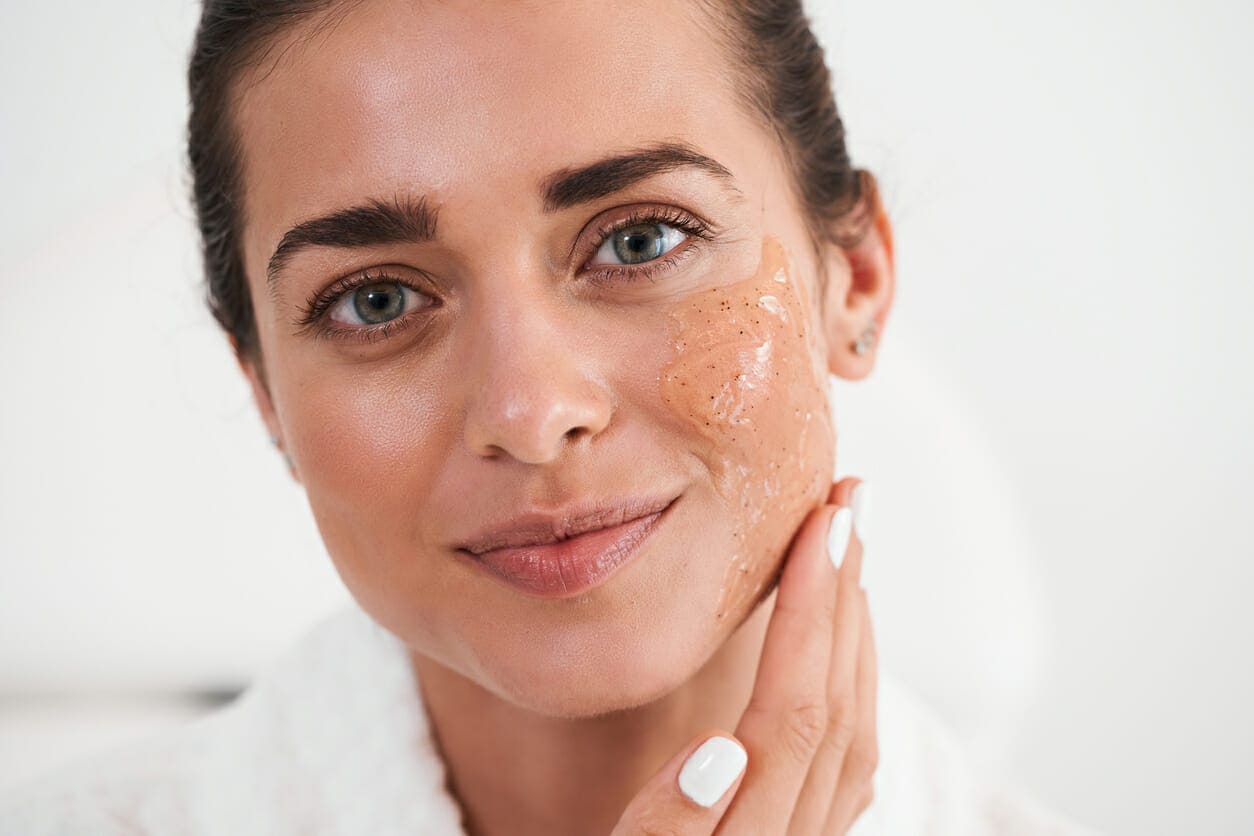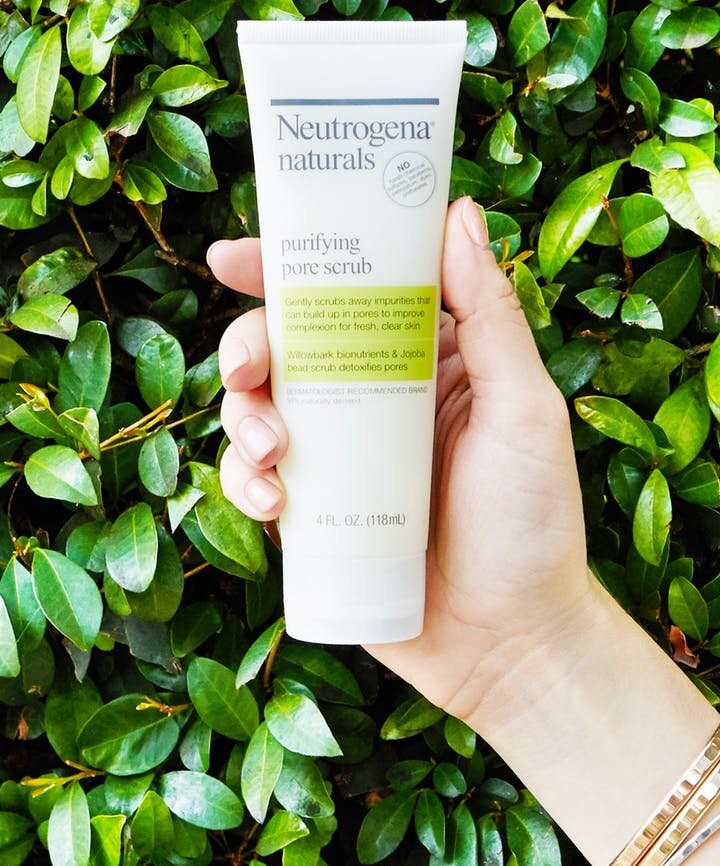
The Skinny on Exfoliating for the Best Skin Ever
Exfoliation is one of my most favorite skincare steps. I love getting my skin back to its natural state – free of sunscreen, dead skin cells, make-up, and any pollutants from the day. It’s such a clean, refreshing feeling!
These days there are so many exfolitating options of scrubs, cleansers, masks, facials, dermaplaning, retinoids, and in-office peels.
With all of these choices you might be wondering what to choose! Then there is the questions if why exfoliate and how often should you exfoliate?
WHAT EXACTLY IS EXFOLIATING?

Remember this? St. Ives Apricot Scrub.
I wouldn’t necessarily recommend this today, but my first exfoliating facial scrub was St Ives Apricot Scrub when I was a teen trying to help my acne. This was before I even knew anything about exfoliating and I was scrubbing my skin to the point of redness in hopes to control some unruly pimples! Now that I’m older, I am using more sophisticated products that are gentler and more targeted for keeping my skin smooth and fighting fines and wrinkles.
Officially, exfoliating is the process of removing dead skin cells from the surface of your skin using a chemical, granular substance, or exfoliation tool.
Mother Nature does her own job of exfoliating and your skin naturally sheds dead skin cells to make room for new cells every 30 days or so. As the new skin cells mature, they travel from the lower layers of your skin to the top epidermal layer. Once they make it to that outer layer, the skin cells are dead. And eventually, they’ll slough off as the newer cells will come to the surface. If dead cells don’t shed completely on their own, it can result in a dull skin tone, flaky patches and clogged pores.
Exfoliation helps your natural sloughing process along. When done correctly, using an exfoliant can help clear off the dead skin cells and unclog pores, revealing newer, younger skin cells below. That glow and brightness you are looking for…exfoliating can help you get that!
6 BENEFITS OF EXFOLIATING:
1) UNCLOGS PORES AND PREVENTS ACNE
Those frustrating clogged pores, that ultimately can turn into acne pimples, are the result of dead skin cells (along with other surface debris) getting trapped in your pores instead of being shed into the environment. If you suffer from acne, your skin creates and sheds dead skin cells faster than someone who doesn’t break out. Someone with normal skin will shed about 30,000 – 40,000 dead skin cells AN HOUR. Acne sufferers’ skin can shed up to 5X that!
Sweeping away those dead skin cells and debris with exfoliation stops them from making their way into your pores and causing stubborn whiteheads and blackheads. Someone who is prone to acne can greatly benefit from exfoliation at home and in a professional dermatology setting. I will typically recommend things like a topical retinoid prescription and/or an AHA cleanser for my acne patients to use and home. Additionally, I love seeing the benefits of faster results and smooth skin when they come in for in-office glycolic and salicylic acid peels (see What’s Up with Chemical Facial Peels).
2) INCREASES CIRCULATION
Just the process of exfoliating can stimulate blood flow to the surface of your skin. This promotes collagen production, encourages healthy cells, and brightens your skin.
3) HELPS OTHER SKINCARE PRODUCTS PENETRATE DEEPER
Exfoliating your skin will help skincare products like antioxidant serums and moisturizers penetrate deeply into your skin to work more effectively. Removing those extra dead skin cells will get your skin to a state of maximum absorption, so those products that you really want to be workhorses for anti-aging penetrating deeper in the skin so that they can work their magic!
4) IMPROVES TONE AND REDUCES BROWN SPOTS/SUN DAMAGE
When your skin gets exposed to the sun, it makes a chemical called melanin to protect itself against further UV damage. Repeated exposure can cause a clump of melanin to form, which shows up as a flat brown or black spot By exfoliating, you can help fade these dark spots by encouraging new skin cells and improving the tone of your skin.
5) IMPROVES TEXTURE
Exfoliating increases your skin cell turnover rate. This means that it will promote new, healthy cells at the surface, and break down and remove the dead, dry, or dying ones. The result is soft skin, smooth texture, a more uniform appearance and a glow that we all strive for!
6) PROMOTES COLLAGEN SYNTHESIS
Collagen is a protein that acts as the structure for our skin and helps with elasticity. It is what we are all trying to get more of (and keep from losing) in our skin to avoid lines, sagging, and wrinkles.
Continued and regular exfoliating over time has been shown to increase collagen production in your skin. Resulting in a complexion that is more plump, tight and young-looking. Amen to that!
THERE ARE 2 TYPES OF EXFOLIATORS…
PHYSICAL AND CHEMICAL:
It sounds complicated, but they are doing a similar thing in different ways. Some people prefer chemical exfoliants over physical ones and vice versa, but it’s up to your specific needs. I actually use both!
PHYSICAL EXFOLIATORS
This is the type of exfoliation that involves you or someone else doing all of the work with either manual scrubbing, rubbing or shaving (in dermaplaning).
The skincare products in this category include: cleansing scrubs (containing beads, sugar, salt and other rough particles), body brushes (that you used by hand or motorized, like Clarisonic), loofahs, exfoliating mitts, and in-office microdermabrasion, dermaplaning, and microneedling.
Physical exfoliation can be effective, but care must be taken. It is easy to overuse them or use them too harshly and cause redness, irritation and even pimples. Make sure to use these gently and look for tiny scrubbing particles that won’t scratch or damage your skin. One tip is to follow up with a humectant moisturizer or hyaluronic acid serum to minimize irritation and lock in moisture.
CHEMICAL EXFOLIATORS
This method uses different chemicals, including acids, retinoids, or enzymes. The benefit of these is that they not only exfoliate the surface dead skin cells away, but also to break the bonds between cells to renew your skin even further and offer more dramatic results. Chemical exfoliants might come in a wash labeled for acne or anti-aging, in a serum, in an at-home peel, or a peel at your dermatology or esthetician office. The difference between a peel at an esthetician office and derm office is strength. In a derm office we can go deeper and do stronger peels. I love doing peels and we have a big variety to choose from!
Some examples of chemical exfoliants include:
Alpha Hydroxy Acids (AHAs) – glycolic (from sugar), lactic (from milk), citrus (from citric fruits), mandelic (from almonds) and malic acids (from apples).
Beta Hydroxy Acids (BHAs) – salicylic acid (from willow trees).
Poly Hydroxy Acids (PHAs) – gluconolactone (made from an acid found in fruit, honey and wine) and lactobionic acid (a sugar acid).
Retinoids – over-the-counter retinol and adapalene (Differin gel), and prescriptions including: tretinoin (Retin A), tazarotene (Tazorac) and alitretinoin (Altreno).
Enzymes – common ones are from fruits including: papaya, pineapple, blueberry, or pumpkin.
I realize that there are a lot of chemical choices out there. Take care choosing, because just as with physical exfoliation, chemical exfoliation can irritate the skin if done incorrectly. If you’re unsure about how to incorporate a chemical product into your skincare routine, make an appointment for a little guidance.
HOW OFTEN SHOULD YOU BE EXFOLIATING?
Believe it or not, you can exfoliate TOO much! The satisfaction of scrubbing the negative and wrong doings off your face cannot be denied. At times it’s tempting to be aggressive and over exfoliate. But taking too much of that protective barrier on your skin’s surface can result in a red and irritated face. The best way to know you are on the right track is to see the glowing results without irritation. Slow and steady is the key! It sounds simple, but ultimately you can exfoliate as often as your skin will tolerate it.
The best way to see what your skin can tolerate is to start with an exfoliator once or twice a week, preferably introducing a chemical exfoliator before a physical one. Chemical ones tend to be less intense and more evenly applied. Physical ones like scrubs tend to cause more irritation if used too aggressively – which is tempting to do at first.
If it feels like your skin can handle more without reacting, then it’s okay to slowly increase as your skin allows. If you notice that your face is stinging and red, or otherwise angry afterward, it’s time to take a step back. You may need to decrease the frequency of use, decrease pressure with your physical exfoliant, or switch to a milder chemical formulation (like lactic or glycolic acid rather than a retinoid). It’s also worth considering your whole skincare routine and avoiding using other potentially irritating products right after you exfoliate. Normal skin can typically handle 5 to 7 times a week with a gentle exfoliant. I like to use my chemical exfoliant wash in the evening to totally remove dirt, oil, make-up and sunscreen from the day.
However, if you have more sensitive skin or rosacea you may only be able to exfoliate once a week. If you know you are sensitive, don’t overdo it! Stick to a gentle exfoliant and make sure to moisturize immediately after to lock in moisture and limit irritation and redness.

WHAT TO LOOK FOR IN A PRODUCT TO USE AT HOME
Your over-the-counter options for exfoliating are almost endless.
Picking a product that will work for you depends on your skin type and your major concerns. If you have dry or sensitive skin, you might have problems tolerating harsh scrubbing products, while someone with oily or acne-prone skin would be able to tolerate them more easily. Here a few suggestions that I tend to reach for…
CLEANSERS:

This cleanses without irritation or over-drying with botanical anti-inflammatory and soothing ingredients like: Willow Bark Extract (a botanical source of Salicylic acid), Date Fruit Extract, Orange Fruit Extract and just the perfect touch of Menthol to make you feel like you just went to the spa!

SKINCEUTICALS MICRO-EXFOLIATING SCRUB
With hydrated silica beads are used to exfoliate instead of micro plastic beads of the past so that it is better for the environment.

Neutrogena Naturals Purifying Pore Scrub
This scrub is fabulous for all skin types, especially great if you struggle with both breakouts and dry, sensitive skin. It contains jojoba beads that are a gentle way to exfoliate, and the addition of willow bark is an excellent way to naturally fight pimples.
LEAVE-ON EXFOLIANTS:

Apply this product at night to help with fine lines and wrinkles as well as fight those stubborn pimples with both Salicylic acid and Azelaic acid!

SkinCeuticals Retexurizing Activator
This hydrating serum contains 20% glycolic acid for fabulous exfoliation without drying out your skin. I alternate this one with my prescription Retin-A/tretinoin cream at night for anti-aging superpower without irritation.

This is a fun combination of 2% dioic acid with alpha and beta hydroxy acids prevent blemishes while diminishing hyperpigmentation and reducing wrinkles and fine lines. You can even use this one to spot treat pimples!

Prescription Only Retin-A/Tretinoin Cream
This is the cream of the crop for exfoliating and collagen production! But watch out for possible irritation with this one. It’s worth asking your derm about this one for great skin texture and tone.
